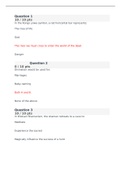Samenvatting
Neuropsychology SUMMARY (Everything you need to know)
- Instelling
- Vrije Universiteit Amsterdam (VU)
This summary includes all the information you need to know for the exam. Some concepts are clarified with information from the Biological Psychology course and from the book, this would help you to understand the course better! Also Includes a practice exam All information from the key point are ...
[Meer zien]












